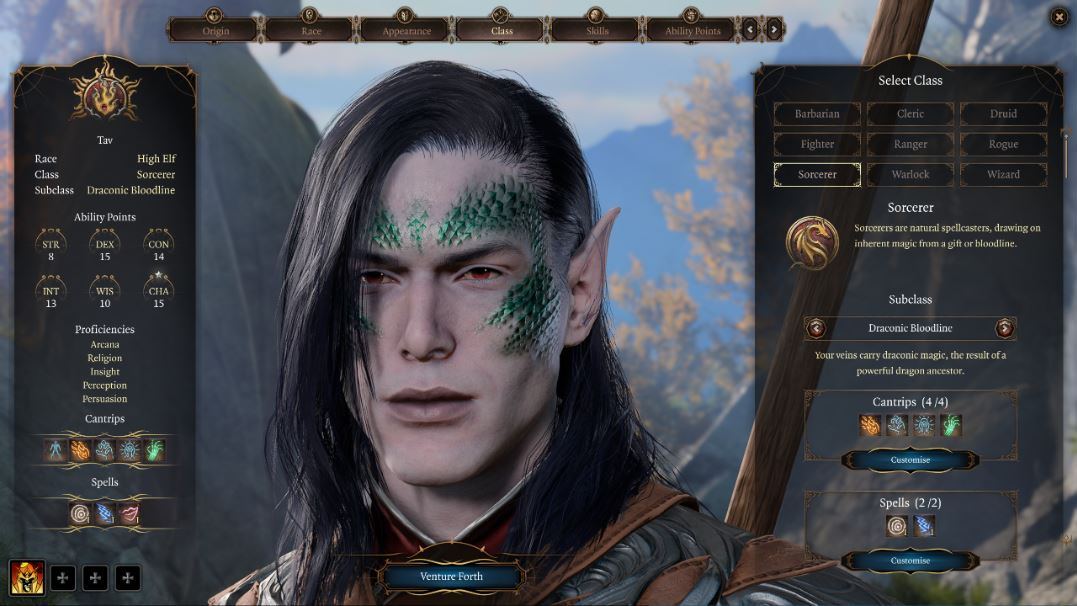Creating the perfect character in Baldur’s Gate 3 is crucial to your adventure. Use a character planner to design your hero’s race, class, abilities, and skills, ensuring your success in the vast world of Faerûn.
Baldur’s Gate 3 is a complex and immersive role-playing game (RPG) set in the Dungeons & Dragons universe. With its deep storytelling, rich character customization, and branching narratives, the game offers players the opportunity to create a unique hero from scratch. Whether you’re new to the game or a seasoned player, using a Character Planner can help you design the perfect adventurer suited to your playstyle and desired role in the story. This guide will walk you through the different aspects of character creation and planning, ensuring that your hero is ready for the challenges ahead in Faerûn.
Why Use a Character Planner in Baldur’s Gate 3?

A Character Planner is a tool that helps players strategize and visualize their character builds before jumping into the game. While Baldur’s Gate 3 allows for flexibility and freedom, planning ahead can save you time and effort. Here are a few reasons why using a character planner is beneficial:
- Maximize Your Potential: A well-thought-out character build can make all the difference in combat, quests, and interactions. Whether you aim to be a powerful spellcaster, a sneaky rogue, or a tanky warrior, planning your character will ensure you focus on the right skills and abilities.
- Know Your Role in the Party: In Baldur’s Gate 3, your character is part of a group of adventurers. Planning your character build helps you complement the strengths and weaknesses of your teammates, creating a balanced and effective party.
- Avoid Regrets: Once you’ve created a character and invested time into their development, it can be frustrating to realize that you’ve made a mistake in your choice of skills, feats, or abilities. A character planner allows you to preview your choices before committing.
- Explore Different Builds: The flexibility of character creation means you can try out different playstyles. A character planner allows you to experiment with different race, class, and ability combinations to find the one that suits you best.
Step-by-Step Guide to Creating Your Character in Baldur’s Gate 3

Step 1: Choose Your Race
In Baldur’s Gate 3, the race of your character will impact both their physical appearance and their in-game abilities. Different races have unique bonuses to certain abilities, and they can also affect your roleplaying experience and interactions with NPCs. Here are some of the races available in the game:
- Human: A versatile and balanced race. Humans get bonuses to all their abilities, making them adaptable to any class.
- Elf: Known for their agility and wisdom, elves excel in dexterity and intelligence, making them ideal for classes like Ranger, Wizard, or Rogue.
- Dwarf: Hardy and resilient, dwarves are great choices for tanky classes like Fighter or Barbarian. They excel in constitution and wisdom.
- Tiefling: With their demonic heritage, Tieflings are often seen as outcasts, but they boast strong charisma and can use infernal magic. They’re a great choice for Warlocks, Sorcerers, or Rogues.
- Githyanki: A race of warrior scholars, Githyanki characters are strong in strength and intelligence, perfect for martial classes or magical warriors.
Tip: Consider how your race’s abilities can complement the class you want to play. For example, an Elf with high Dexterity makes an excellent Rogue, while a Dwarf’s high Constitution is perfect for a tanky Fighter.
Step 2: Select Your Class
Your class defines your character’s abilities, skills, and overall role in the game. In Baldur’s Gate 3, there are several classes to choose from, each with a unique set of strengths and abilities:
- Fighter: A reliable choice for players who want to engage in combat directly. Fighters are skilled in both weapon and armor use, making them ideal frontline warriors.
- Rogue: Masters of stealth, deception, and trickery, Rogues excel at avoiding damage while dealing heavy backstabbing blows. A high Dexterity stat is crucial for this class.
- Wizard: Wizards are spellcasters who wield powerful arcane magic. They have a wide variety of spells but are fragile, so they often rely on other party members to protect them.
- Cleric: A divine spellcaster who supports the team with healing and protective spells. Clerics can be versatile, serving as both healers and front-line fighters depending on their chosen domain.
- Warlock: Warlocks are spellcasters who gain their power through pacts with powerful beings. They combine powerful magic with a range of combat abilities.
- Barbarian: Barbarians are fierce, rage-fueled warriors who can deal devastating damage in battle. They excel in strength and durability.
- Ranger: Rangers are versatile warriors skilled in ranged combat, tracking, and nature-based magic. They can summon animal companions and excel in the wilderness.
Tip: Choose a class that matches the playstyle you enjoy. If you like to be in the thick of combat, consider a Fighter or Barbarian. If you enjoy casting spells from a distance, a Wizard or Warlock might be more your style.
Step 3: Assign Your Ability Scores
Your character’s ability scores determine their effectiveness in various tasks, including combat and skill checks. In Baldur’s Gate 3, you’ll need to assign points to six abilities: Strength, Dexterity, Constitution, Intelligence, Wisdom, and Charisma.
- Strength: Affects physical attacks and carrying capacity. Important for melee classes like Fighters or Barbarians.
- Dexterity: Influences ranged combat, stealth, and initiative. Crucial for Rogues, Rangers, and certain spellcasters.
- Constitution: Impacts health and resistance to fatigue or poisons. A high Constitution is key for tanky builds.
- Intelligence: Affects spellcasting for Wizards and knowledge-based skills. Important for tactical and intellectual builds.
- Wisdom: Tied to perception, survival, and certain spellcasting abilities like those of Clerics and Rangers.
- Charisma: Governs social interactions, persuasion, and certain spellcasting abilities like those of Sorcerers and Warlocks.
Tip: Focus on abilities that match your chosen class. For example, a Rogue benefits from high Dexterity, while a Fighter may prioritize Strength and Constitution.
Step 4: Choose Your Skills and Proficiencies
In addition to your ability scores, you’ll also need to choose which skills your character is proficient in. These skills will determine how well your character can perform tasks like persuasion, acrobatics, or investigation.
Common Skills include:
- Acrobatics: For physical feats and dodging attacks.
- Athletics: For climbing, swimming, and heavy lifting.
- Deception: For lying and tricking others.
- Insight: For reading people and understanding their intentions.
- Perception: For noticing hidden things or detecting traps.
Tip: Choose skills that align with your character’s backstory and role in the party. For instance, a Rogue might focus on Stealth and Sleight of Hand, while a Cleric may prefer Medicine and Insight.
Step 5: Select Your Background
Your background provides further context for your character’s past and grants additional proficiencies. It also influences the story and interactions with NPCs. Some backgrounds include:
- Soldier: Grants proficiency in Athletics and Intimidation. Perfect for a combat-focused character.
- Noble: Gives proficiency in History and Persuasion, useful for social interactions.
- Criminal: Offers proficiency in Deception and Stealth, ideal for Rogues or shady characters.
Tip: Your background should complement your character’s backstory and role in the game. If you want to play a character with a military background, choose Soldier, or if your character has a history of deceit, choose Criminal.
Step 6: Customize Your Appearance
Once your character’s abilities and skills are finalized, it’s time to personalize their look. Baldur’s Gate 3 offers detailed customization options for facial features, hairstyle, armor, and more. You can make your character as unique as you like, from their skin color and eye shape to their clothing and accessories.
Tip: While your appearance doesn’t affect gameplay, creating a character you love to look at can enhance your immersion in the game. Take time to adjust your character’s features and make them feel like your own.
Step 7: Finalize Your Character Build
After completing all the steps above, review your character’s stats, abilities, and appearance. Make sure everything aligns with your desired playstyle and role in the party. Baldur’s Gate 3 is an expansive game, and while it allows for respecing your character later, it’s still a good idea to have a clear vision for your character before diving in.




